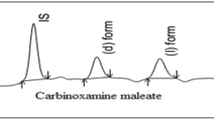Abstract
In order to study the simultaneous determination of (+)- and (−)-cetirizine in human urine we have developed a chiral separation method by HPLC. A chiral stationary phase of α1-acidglycoprotein, the AGP-CSP, was used to separate the enantiomers. The pH of the phosphate buffer, as well as the content of the organic modifier in the mobile phase, markedly affected the chromatographic separation of (+)- and (−)-cetirizine. A mobile phase of 10 mmol/l phosphate buffer (pH 7.0)-acetonitrile (95∶5, v/v) was used for the urine assays. Ultraviolet absorption was monitored at 230nm and roxatidine was employed as the internal standard for quantification.
(+)-Cetirizine, (−)-cetirizine and the internal standard were eluted at retention times of 12, 16, and 32 mins, respectively. The detection limit for cetirizine enantiomers was 400 ng/ml of urine. A pharmacokinetic study was conducted with the help of 5 healthy female volunteers who were administered with a single oral dose of racemic cetirizine (20 mg). The peak area ratios provided by the cetirizine enantiomers were linear(r>0.997) over a concentration range of 2.5-200 μg/ml. The peak of the excreted cetirizine enantiomers appeared in the urine sample during the period of 1–2 hrs following the administration of the oral dose. The excreted level of (+)-cetirizine was slightly higher than (−)-cetirizine but the difference was not statistically significant. However, this method appears to have applications for enantioselective pharmacokinetic studies of racemic drugs.
Similar content being viewed by others

References
Eiichi, S., Seiji, Y., Yukisumi, I., Nororu, H. and Hiroshi, N., The optical resolution of racemic chlorpheniramine and its stereoselective pharmacokinetics in rat plasma.J. pharm. pharmacol., 44, 44–47 (1992).
Gray, N. M., Methods for treating urticaria using optically pure (+)-cetirizine.U. S. Patent, 5, 698, 558 (1997).
Gray, N. M., Methods for treating allergic disorders using optically pure (−)-cetirizine.U. S. Patent, 5, 627, 183 (1997).
Kaliszan, R., Nasal, A., Turowski, M., Quantitative structure-retention relationships in the examination of the topography of the binding site of antihistamine drugs on alpha 1-acid glycoprotein.J. Chromatogr., 722, 25–32 (1996).
Mehta, A. C., Direct separation of drug enantiomers by high performance liquid chromatography with chiral stationary phases.J. Chromatogr., 426, 1(1988).
Miwa, T., Miyakawa, T., Kayano, M. and Miyake, Y., Application of an ovomucoid-conjugated column for the optical resolution of some pharmaceutically important compounds.J. Chromatogr., 408, 316 (1987).
Monica, W. H., Chromatographic separation of aramatic carboxylic acids.J. Chromatogr. B., 717, 93–118 (1998).
M. T. Roussel and R. A. Lefebvre, Determination of cetirizine in human urine by high-performance liquid chromatography.J. Chromatogr., 565, 504–510 (1991).
Nasal, A., Radwanska, A., Osmialowski, K., Bucinski, A., Kaliszan, R., Barker, GE., Sun, P., Hartwick, RA., Quantitative relationships between the structure of beta-adrenolytic and antihistamine drugs and their retention on an alpha 1-acid glycoprotein HPLC column.Boimed. Chromatogr., 8, 125–129 (1994).
Nishikata, M., Nakai, A., Fushida, H., Miyake, K., Arita, T., Kitagawa, S., Kunitomo, M., Iseki, K. and Miyazaki, K., Method for optical resolution of racemic homochlorcyclizine and comparison of optical isomers in antihistamine activity and pharmacokinetics.Chem. Pharm. Bull., 40, 1341 (1992).
Nishikata, M., Nakai, A., Fushida, H., Miyake, K., Arita, T., Simultaneous determination of (+)- and (−)-homochlorcyclizine in human urine by high-performance liquid chromatography.J. Chromatogr., 612, 239–244 (1993).
Pagliara, A., Testa, B., Carrupt, P., Jolliet, P., Morin, C., Morin, D., Urien, S., Tillement, J. and Rihoux, J., Molecular properties and pharmacokinetic behavior of cetirizine, a zwitterionic H1-receptor antagonist.J. Med. Chem., 41, 853–863 (1998).
Persson, B. A., Balmer, K. and Legerstrom, P.O., Enantio-selective determination of metoprolol in plasma by liquid chromatography on a silica-bonded alpha 1-acid glycoprotein column.J. Chromatogr., 500, 629–636 (1990).
Schill, G., Wainer, I. W., Barkan, S. A., Chiral separation of cationic drugs on an α1-acid glycoprotein bonded stationary phase.J. Liquid Chromatogr., 9, 641–666 (1986).
Author information
Authors and Affiliations
Corresponding author
Rights and permissions
About this article
Cite this article
Choi, S.O., Lee, S.H., Kong, H.S. et al. Enantioselective determination of cetirizine in human urine by HPLC. Arch Pharm Res 23, 178–181 (2000). https://doi.org/10.1007/BF02975510
Received:
Issue Date:
DOI: https://doi.org/10.1007/BF02975510



